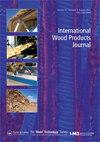以木渣和消费后聚乙烯废料为建筑材料的木塑复合材料的物理力学性能
IF 0.9
Q2 MATERIALS SCIENCE, PAPER & WOOD
引用次数: 0
摘要
木渣和塑料废弃物是环境污染物。工程木塑复合材料(WPCs)作为结构材料的成功取决于其性能。研究了三龙鱼木屑和聚乙烯水包复合材料的物理力学性能。组件(复合材料A = 10:90%木塑,B = 25:75%和C = 50:50%重量)被挤压和模压成标准尺寸进行物理(即吸水性和硬度)和机械(即拉伸和冲击强度)测试。与复合材料C(分别为0.08±0.01%和40.30±0.04 N mm−2)相比,复合材料A的吸水率最低(0.02±0.01%),硬度最高(51.40±0.01 N mm−2)。复合材料的抗拉强度范围为30.64±0.12 N mm−2(复合材料C)至34.78±0.09 N mm−2(复合材料B),影响范围为0.50±0.01 J(复合材料C)至0.90±0.01 J(复合材料A)。木渣和塑料废弃物的工程利用将缓解木材过度开发和减少环境污染威胁,有助于缓解木材过度开发和减少环境污染威胁。本文章由计算机程序翻译,如有差异,请以英文原文为准。
Physico-mechanical properties of wood–plastic composites from Triplochiton scleroxylon K. Schum wood-residue and post-consumer polyethylene waste as construction materials
ABSTRACT Wood-residues and plastic wastes are environmental pollutants. The success of engineered Wood–Plastic Composites (WPCs) as structural materials depends on their properties. The physico-mechanical properties of WPCs from Triplochiton scleroxylon sawdust and post-consumer polyethylene water sachet were assessed. The components (Composite A = 10:90% wood–plastic, B = 25:75% and C = 50:50% by weight) were extruded and moulded into standard dimensions for physical (i.e. water absorption and hardness) and mechanical (i.e. tensile and impact strength) tests. Composite A absorbed the least water (0.02 ± 0.01%) and recorded the greatest hardness (51.40 ± 0.01 N mm−2) compared with Composite C (0.08 ± 0.01% and 40.30 ± 0.04 N mm−2 respectively). Tensile strength ranged from 30.64 ± 0.12 N mm−2 (Composite C) to 34.78 ± 0.09 N mm−2 (Composite B), and the impact from 0.50 ± 0.01 J (Composite C) to 0.90 ± 0.01 J (Composite A). The engineering and utilisation of wood-residue and plastic waste into composites would ease timber over-exploitation and minimise environmental pollution threats, contribute to ease timber over-exploitation and minimise environmental pollution threats.
求助全文
通过发布文献求助,成功后即可免费获取论文全文。
去求助
来源期刊

International Wood Products Journal
MATERIALS SCIENCE, PAPER & WOOD-
CiteScore
2.40
自引率
0.00%
发文量
27
 求助内容:
求助内容: 应助结果提醒方式:
应助结果提醒方式:


